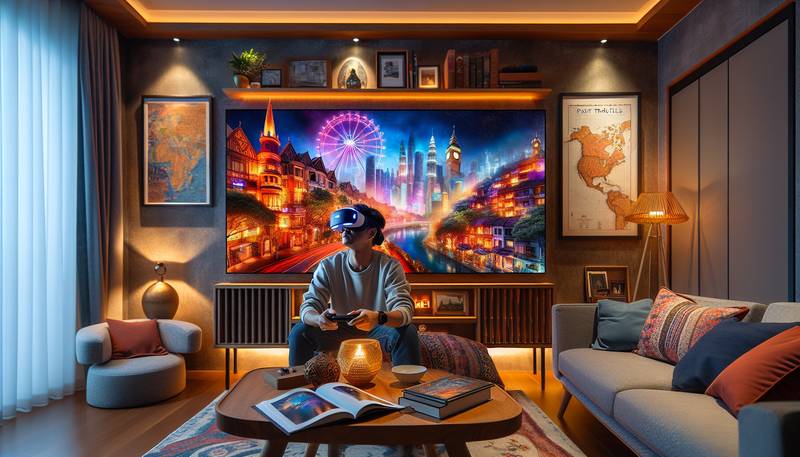Virtual Tourism: Exploring the World from Your Living Room

The world is a beautiful, vast, and diverse place, but not everyone has the opportunity or means to physically travel and explore its many wonders. Thanks to advances in technology, virtual tourism offers an alternative way to experience new destinations from the comfort of your own home. This innovative approach to travel allows you to visit landmarks, museums, and natural wonders around the globe without ever having to leave your living room.
What is Virtual Tourism?
Virtual tourism, also known as virtual travel or virtual reality (VR) tourism, is an immersive experience that uses technology to simulate visiting different locales. This can be done through various mediums such as VR headsets, 360-degree videos, interactive tours, and even video games. These experiences are designed to make you feel as though you are actually at the destination, seeing the sights, and even interacting with the environment.
The Benefits of Virtual Tourism
Virtual tourism offers several benefits over traditional travel. Firstly, it is cost-effective. You don't need to spend money on flights, hotels, or other travel expenses. Instead, you can virtually visit many places for free or for a small fee. It's also more accessible, as people with mobility issues or limited travel opportunities can experience the thrill of exploration without any physical barriers.
Virtual tourism is also environmentally friendly. By reducing air travel, we can decrease our carbon footprint and help protect the planet. Additionally, virtual tours can reduce the impact of overtourism on popular destinations, which can be harmful to the local environment and communities.
Immersive Virtual Reality Experiences
One of the most exciting ways to experience virtual tourism is through immersive VR technology. By wearing a VR headset, you can be transported to a different world, complete with sights, sounds, and even tactile feedback. You can stroll through the cobbled streets of Rome, explore the depths of the ocean, or climb the snowy peaks of Mount Everest, all without leaving your couch.
Some popular VR travel experiences include Google Earth VR, which allows you to fly over cities and landscapes, and The Grand Canyon VR Experience, which offers a breathtaking journey through one of the most iconic natural wonders in the United States.
Virtual Tours of Museums and Historical Sites
Many cultural institutions and historical sites have embraced virtual tourism by offering online tours that allow you to explore their collections and architecture. This provides an incredible opportunity to visit world-renowned museums like the Louvre in Paris, the British Museum in London, or the Smithsonian Institution in Washington, D.C., without ever having to stand in line or navigate through the crowds.
Furthermore, virtual tours often provide in-depth information and educational content, making them valuable learning tools. They can include interactive elements such as quizzes or games, enhancing the overall experience and making it both educational and entertaining.
360-Degree Videos and Live Webcams
If VR technology isn't accessible to you, there are still plenty of ways to enjoy virtual tourism. Many platforms offer 360-degree videos of popular destinations, where you can click and drag to look around as if you're actually there. Websites like YouTube host countless high-quality videos of natural wonders, cityscapes, and cultural events from around the world.
Live webcams also provide real-time views of various locations, allowing you to experience places like Times Square in New York City or the canals of Venice as they are at this very moment. It can almost feel like people-watching from a distance, adding a sense of connection to the broader world.
Video Game Adventures
Video games have become an unexpected yet fantastic medium for virtual travel. Open-world games like Assassin's Creed, which are set in historical periods and locations, offer richly detailed environments that are meticulously researched and beautifully rendered. You can explore ancient Egypt, Renaissance Italy, or colonial America while engaging in interactive storytelling.
Other games like Microsoft Flight Simulator allow you to pilot an aircraft over detailed recreations of cities and landscapes, satisfying your wanderlust and giving you a taste of what it's like to fly around the world.
Challenges and Limitations
While virtual tourism provides an incredible opportunity to explore the world, it does have its limitations. Firstly, the experience might not be as immersive as actually being at the destination. The smells, tastes, and tactile sensations of travel cannot be fully replicated through technology. Additionally, virtual tourism might raise ethical concerns regarding the commodification of culture and the potential loss of revenue for communities that rely on tourism.
Conclusion
Virtual tourism offers a unique and exciting way to explore far-off places without ever having to leave your living room. Whether through VR headsets, interactive tours, 360-degree videos, or video games, there are endless opportunities to travel the world virtually. While it may never fully replace the experience of physical travel, virtual tourism opens up new horizons for those who are curious, adventurous, and passionate about discovering all that our incredible world has to offer.


